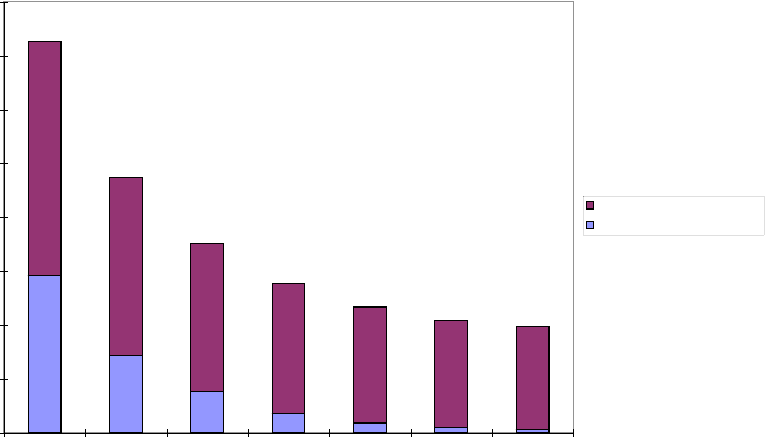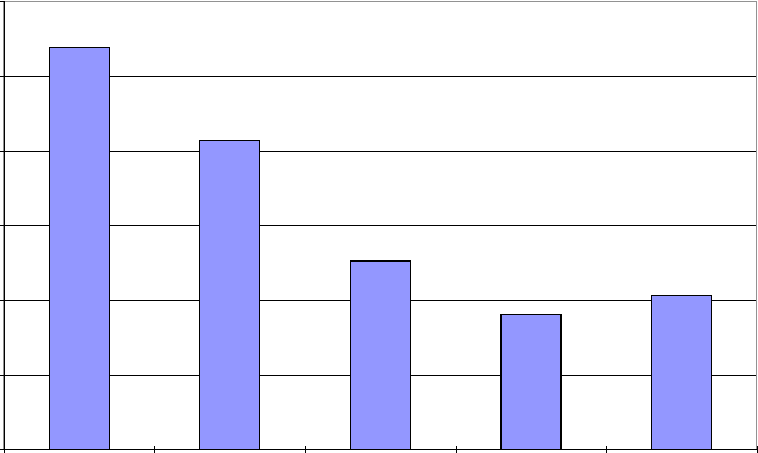Damodaran A. Applied corporate finance
Подождите немного. Документ загружается.


28
28
Using the Bookscape example again, if the venture capitalist requires a target return
on 30% on his or her investment, the discounted terminal value for Bookscape would
be
Discounted Terminal value for Bookscape = $ 100 million/1.30
3
= $ 45.52 million
3. Structuring the Deal: In structuring the deal to bring private equity into the firm, the
private equity investor and the firm have to negotiate two factors. First, the private
equity investor has to determine what proportion of the value of the firm he or she
will demand, in return for the private equity investment. The owners of the firm, on
the other hand, have to determine how much of the firm they are willing to give up in
return for the same capital. In these assessments, the amount of new capital being
brought into the firm has to be measured against the estimated firm value. In the
Bookscape example, assuming that the venture capitalist is considering investing $ 12
million, he or she would want to own at least 26.36% of the firm.
7
Ownership proportion = Capital provided/ Estimated Value
= $ 12/ $ 45.52 = 26.36%
Second, the private equity investor will impose constraints on the managers of the
firm in which the investment is being made. This is to ensure that the private equity
investors are protected and that they have a say in how the firm is run.
4. Post-deal Management: Once the private equity investment has been made in a firm,
the private equity investor will often take an active role in the management of the
firm. Private equity investors and venture capitalists bring not only a wealth of
management experience to the process, but also contacts that can be used to raise
more capital and get fresh business for the firm.
5. Exit: Private equity investors and venture capitalists invest in private businesses
because they are interested in earning a high return on these investments. How will
these returns be manifested? There are three ways in which a private equity investor
can profit from an investment in a business. The first and usually the most lucrative
alternative is an initial public offering made by the private firm. While venture
7
Many private equity investors draw a distinction between pre-money valuation, or the value of the
company without the cash inflow from the private equity investor, and post-money valuation, which is the

29
29
capitalists do not usually liquidate their investments at the time of the initial public
offering, they can sell at least a portion of their holdings once they are traded
8
. The
second alternative is to sell the private business to another firm; the acquiring firm
might have strategic or financial reasons for the acquisition. The third alternative is to
withdraw cash flows from the firm and liquidate the firm over time. This strategy
would not be appropriate for a high growth firm, but it may make sense if investments
made by the firm no longer earn excess returns.
From Private to Publicly Traded Firm: The Initial Public Offering
A private firm is restricted in its access to external financing, both for debt and
equity. In our earlier discussion of equity choices, we pointed out the hard bargain
venture capitalists extract for investing equity in a private business. As firms become
larger and their capital needs increase, some of them decide to become publicly traded
and to raise capital by issuing shares of their equity to financial markets.
Staying Private versus Going Public
When a private firm becomes publicly traded, the primary benefit is increased
access to financial markets and to capital for projects. This access to new capital is a
significant gain for high growth businesses, with large and lucrative investment
opportunities. A secondary benefit is that the owners of the private firm are able to cash
in on their success by attaching a market value to their holdings. These benefits have to
be weighed against the potential costs of being publicly traded. The most significant of
these costs is the loss of control that may ensue from being a publicly traded firm. As
firms get larger and the owners are tempted to sell some of their holdings over time, the
owner’s share of the outstanding shares will generally decline. If the stockholders in the
firm come to believe that the owner’s association with the firm is hurting rather than
helping it, they may decide to put pressure for the owner’s removal. Other costs
associated with being a publicly traded firm are the information disclosure requirements
value of the company with the cash influx from the private equity investors. They argue that their
ownership of the firm should be based upon the former (lower) value.
8
Black and Gilson (1998) argue that one of the reasons why venture capital is much more active in the
U.S. than in Japan or Germany is because the option to go public is much more easily exercised in the U.S.

30
30
and the legal requirements
9
. A private firm experiencing challenging market conditions
(declining sales, higher costs) may be able to hide its problems from competitors,
whereas a publicly traded firm has no choice but to reveal the information. Yet another
cost is that the firm has to spend a significant portion of its time on investor relations, a
process in which equity research analysts following the firm are cultivated
10
and provided
with information about the firm’s prospects.
Overall, the net tradeoff to going public will generally be positive for firms with
large growth opportunities and funding needs. It will be smaller for firms that have
smaller growth opportunities, substantial internal cash flows, and owners who value the
complete control they have over the firm.
Steps in an initial public offering
Assuming that the benefits outweigh the costs, there are five steps involved in an
initial public offering.
Step 1: Choose an investment banker based upon reputation and marketing skills. In most
initial public offerings, this investment banker underwrites the issue and guarantees a
specified price for the stock. This investment banker then puts together a group of several
banks (called a syndicate) to spread the risk of the offering and to increase marketing
reach.
Step 2: Assess the value of the company and set issue details: This valuation is generally
done by the lead investment bank, with substantial information provided by the issuing
firm. The value is sometimes estimated using discounted cash flow models. More often,
though, the value is estimated by using a multiple, like a price earnings ratio, and by
looking at the pricing of comparable firms that are already publicly traded. Whichever
approach is used, the absence of substantial historical information, in conjunction with
the fact that these are small companies with high growth prospects, makes the estimation
of value an uncertain one at best. Once the value for the company has been estimated, the
9
The costs are two fold. One is the cost of producing and publicising the information itself. The other is the
loss of control over how much and when to reveal information about the firm to others.
10
This may sound like an odd term, but it is accurate. Buy recommendations from equity research analysts
following the firm provoke investor interest and can have a significant impact on the stock price; sell

31
31
value per share is obtained by dividing by the number of shares, which is determined by
the price range the issuer would like to have on the issue. If the equity in the firm is
valued at $ 50 million, for example, the number of shares would be set at 5 million to get
a target price range of $10, or at 1 million shares to get a target price range of $ 50 per
share. The final step in this process is to set the offering price per share. Most investment
banks set the offering price below the estimated value per share for two reasons. First, it
reduces the bank’s risk exposure. If the offering price is set too high and the investment
bank is unable to sell all of the shares being offered, it has to use its own funds to buy the
shares at the offering price. Second, investors and investment banks view it as a good
sign if the stock increases in price in the immediate aftermath of the issue. For the clients
of the investment banker who get the shares at the offering price, there is an immediate
payoff; for the issuing company, the ground has been prepared for future issues.
Step 3: Gauge investor demand at the offering price: In setting the offering price,
investment bankers have the advantage of first checking investor demand. This process,
which is called building the book, involves polling institutional investors prior to pricing
an offering, to gauge the extent of the demand for an issue. It is also at this stage in the
process that the investment banker and issuing firm will present information to
prospective investors in a series of presentations called road shows. In this process, if the
demand seems very strong, the offering price will be increased; in contrast, if the demand
seems weak, the offering price will be lowered. In some cases, a firm will withdraw
11
an
initial public offering at this stage, if investors are not enthusiastic about it.
Step 4: Meet SEC filing requirements and issue a prospectus: In order to make a public
offering the United States, firms have to meet several requirements. First, they have to
file a registration statement and prospectus with the SEC, providing information about
the firm’s financial history, its forecasts for the future and how it plans for the funds it
raises from the initial public offering. The prospectus provides information about the
riskiness and prospects of the firm for prospective investors in its stock. The SEC reviews
this information and either approves the registration or sends out a deficiency
recommendations, on the other, can cause the stock price to drop. This is especially true for small,
unknown firms.

32
32
memorandum asking for more information. While the registration is being reviewed, the
firm may not sell any securities, though it can issue a preliminary prospectus, titled a red
herring, for informational purposes only. Once the registration has been approved by the
SEC, the firm can place a tombstone advertisement in newspapers and other
publications.
Step 5: Allocate stock to those who apply to buy it at offering price: If the demand for the
stock exceeds the supply (which will happen if the offering price is set too low), you will
have to ration the stock. If the supply exceeds the demand, the investment banker will
have to fulfill the underwriting guarantee and buy the remaining stock at the offering
price.
On the offering date –– the first date the shares can be traded –– the market price
is determined by demand and supply. If the offering price has been set too high, as is
sometimes the case, the investment bankers will have to discount the offering to sell it
and make up the difference to the issuer, because of the underwriting agreement. If the
offering price is set too low, as is often the case, the traded price on the offering date will
be much higher than the market price, thus enriching those who were allocated shares in
the initial public offering.
The Costs of Going Public
There are three costs associated with an initial public offering. First, the firm must
consider the legal and administrative cost of making a new issue, including the cost of
preparing registration statements and filing fees. Second, the firm should examine the
underwriting commission –– the gross spread between the offering price and what the
firm receives per share, which goes to cover the underwriting, management, and selling
fees on the issue. This commission can be substantial and decreases as the size of the
issue increases. Figure 7.6 summarizes the average issuance and underwriting costs for
issues of different sizes, reported by Ritter (1998).
11
One study of initial public offerings between 1979 and 1982 found that 29% of firms terminated their
initial public offerings at this stage in the process.

33
33
Source: Ritter
The third cost is any underpricing on the issue, which provides a windfall to the investors
who get the stock at the offering price and sell it at the much higher market price. Thus,
for Netscape, whose offering price was $29 and whose stock opened at $50, the
difference of $21 per share on the shares offered, is an implicit cost to the issuing firm.
While precise estimates vary from year to year, the average initial public offering seems
to be underpriced by 10-15%. Ibbotson, Sindelar, and Ritter (1993), in a study of the
determinants of underpricing, estimate its extent as a function of the size of the issue.
Figure 7.7 summarizes the underpricing as a percent of the price by size of issue.
Figure7.6: Issuance Costs by Size of Issue
0.00%
2.00%
4.00%
6.00%
8.00%
10.00%
12.00%
14.00%
16.00%
<1.99 2.00 -4.99 5.00 - 9.99 10.00 -
19.99
20.00 -
49.99
50.00 -
99.99
100.00 -
500.00
Size of Issue (in millions)
Costs (%)
Underwriting Commission
Issuance Expenses

34
34
Figure 7.7: Underpricing as percent of Price - By Issue Size
0.00%
5.00%
10.00%
15.00%
20.00%
25.00%
30.00%
< 1.9 2 - 3.99 4 - 5.99 6 - 9.99 10 - 120
Size of Issue
Underpricing (%)
Source: Ibbotson, Sindelar and Ritter
Private firms tend to pick investment bankers based upon reputation and
expertise, rather than price. A good reputation provides the credibility and the comfort
level needed for investors to buy the stock of the firm; expertise applies not only to the
pricing of the issue and the process of going public but also to other financing decisions
that might be made in the aftermath of a public issue. The investment banking agreement
is then negotiated, rather than opened up for competition.

35
35
Illustration 7.2: The Initial Public Offering for United Parcel Service
On July 21, 1999, United Parcel Service, the world’s largest private package
company, announced plans to sell its shares to the public. The company, which was
wholly owned by its managers and employees, announced that it was going public in
order to raise capital to make acquisitions in the future. UPS reported revenues of $ 24.8
billion and net income of $ 1.7 billion in 1998 and at that time employed about 330,000
people.
UPS followed the initial announcement by filing a prospectus with the SEC on the
same day, announcing its intention of creating two classes of shares. Class A shares, with
10 votes per share, would be held by the existing owners of UPS, and class B shares,
having one vote per share, would be offered to the public.
The firm chose Morgan Stanley as its lead investment banker, and Morgan
Stanley put together a syndicate that included Goldman Sachs and Merrill Lynch as
senior co-managers. Other co-managers included Credit Suisse, Salomon Smith Barney
and Warburg Dillon Read. On October 20, 1999, UPS filed a statement with the SEC
(called an S-1 registration statement) announcing that it planned to issue 109.4 million
shares (about 10% of the 1.1 billion outstanding shares) at a price range
12
of $ 36 to $ 42,
and that the initial public offering would occur sometime in early November.
Based upon the strong demand from institutional investors, gauged in the process
of building the book, the investment banking syndicate increased the offering price to $
50 per share on November 8, 1999, and set the offering date at November 10, 1999. At
that time, it was the largest initial public offering ever by a U.S. company.
On November 10, 1999, the stock went public. The stock price jumped to $
70.1325 from the offering price of $ 50. At the end of the trading day, UPS shares were
trading at $ 67.25. Based upon this price and the total number of shares outstanding, the
market value of UPS was assessed at $ 80.9 billion.
12
The process by which this price range was set was not made public. We would assume that it was
partially based upon how the market was pricing two other publicly traded rivals – Fed Ex and Airborne
Freight.

36
36
7.9. ☞: The Cost of Underrpricing
Assume that the market is correct in its assessment of UPS value and that the investment
bankers underpriced the issue. How much did the underpricing cost the owners of UPS?
a. About $ 22 billion
b. About $ 50 billion
c. About $ 2.2 billion
d. None of the above
In Practice: The Underpricing of IPOs
Investment bankers generally underprice initial public offerings and are fairly
open about the fact that they do. This gives rise to two questions. First, why don’t the
offering firms express more outrage about the value left on the table by the underpricing?
Second, can investors take advantage of the underpricing by subscribing to dozens of
initial public offerings? There are simple answers to both questions.
It is true that an underpriced initial public offering results in less proceeds going
to the issuing firms. However, the loss of wealth is a function of how much of the equity
of the firm is offered in the initial offering. If, as in the UPS offering, only 10% of the
stock is being offered, we can see why many issuing firms go along with the
underpricing. The favorable publicity associated with a strong opening day of trading
may act as promotion for subsequent offerings that the firm plans to make in future
months or even years.
It is not easy constructing an investment strategy that takes advantage of the IPO
mispricing. If an investor applies for shares in a number of offerings, she is likely to get
all the shares she requests in the offerings that are over priced and only a fraction of the
shares she requests in the offerings that are underpriced (where there will be rationing
because of excess demand). The resulting portfolio will be overweighted in overpriced
public offerings and underweighted with the underpriced offerings, and the returns will
not match up to those reported in IPO studies.

37
37
The Choices for a Publicly Traded Firm
Once a firm is publicly traded, it can raise new financing by issuing more
common stock, equity options or corporate bonds. Additional equity offerings made by
firms that are already publicly traded are called seasoned equity issues. In making stock
and bond offerings, a publicly traded firm has several choices. It can sell these securities
with underwritten general subscriptions, through stocks and bonds are offered to the
public at an offering price guaranteed by the investment banker. It can also privately
place both bonds and stocks with institutional investors, or issue stocks and bonds
directly to investors, without any middlemen.
General Subscriptions
In a general subscription, the issue is open to any member of the general public
to subscribe. In that sense, it is very similar to an initial public offering, though there are
some basic differences:
• Underwriting Agreement: The underwriting agreement of an initial public offering
almost always involves a firm guarantee and is generally negotiated with the
investment banker, while the underwriting agreements for seasoned issues take on a
wider variety of forms. First, there is the potential for competitive bids to arise on
seasoned issues, since investment bankers have the information
13
to promise a fixed
price. There is evidence that competitive bids reduce the spread, though even
seasoned firms continue to prefer negotiated offerings. Second, seasoned issues also
offer a wider range of underwriting guarantees; some issues are backed up by a best
efforts guarantee, which does not guarantee a fixed price; other issues come with
stand-by guarantees, where the investment banker provides back-up support, in case
the actual price falls below the offering price. The payoff from relaxing the guarantee
comes as lower underwriting commissions.
• Pricing of Issue: The issuer of an initial public offering has to estimate the value of
the firm and then the per-share value before pricing the issue, while the pricing of a
13
The information takes two forms. The first are the filings that every publicly traded firm has to make
with the SEC. The other, and more important, is the current stock price.
